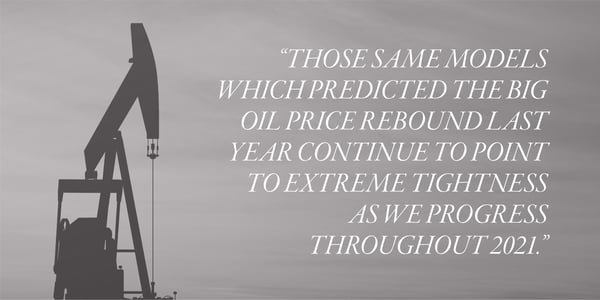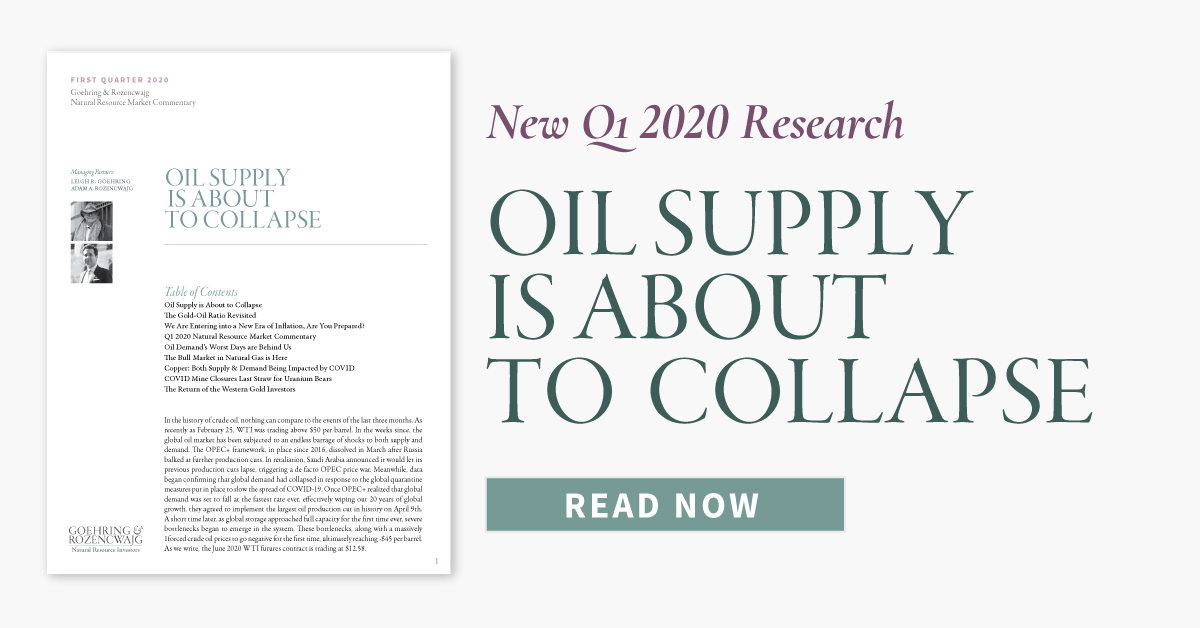Exactly one year after West Texas Intermediate crude reached its historic -$37 per barrel low, the damage inflicted on global oil markets from the COVID-19 economic lockdowns has been largely repaired. Inventories have drawn down at the fastest rate on record and in a mere 12 months nearly all excess crude inventories have been eliminated. Prices for Brent and WTI recently topped $70 per barrel. Exploration and production equities (as measured by the XOP) have led the broad market higher, advancing 170% since the beginning of April 2020.
In the midst of last year’s turmoil, we released a podcast on March 10th, 2020, discussing the severe volatility and weakness in global crude markets. We explained how falling productivity in the shales would cause the market to recover much faster than anyone expected. We advocated investors maintain or add to their energy exposure, an extremely bold call at the time. As with any prediction, we got some elements right and others wrong, but on balance we were correct. Not only has the oil market rebounded sharply over the past 12 months, but the drivers of the recovery have been consistent with our analysis. We bring this up because those same models which predicted the big oil price rebound last year continue to point to extreme tightness as we progress throughout 2021.
Global oil markets are firmly in deficit, as evidenced by rising prices, falling inventories, and growing backwardation. After having peaked in June 2020 at nearly 400 mm bbl above average, OECD inventories have drawn by 250 mm bbl relative to seasonal averages, suggesting the market has been 1.2 m b/d in deficit — the highest reading on record. We expect this deficit will grow as we progress through the year. Inventory data in the US shows continued draws relative to seasonal averages in March and April, albeit at a slower rate.
We should point out however, that extreme weather in Texas impacted production, demand, and net imports leaving the data difficult to analyze properly. With the Texas weather disruptions behind us, we expect US inventories will again resume their sharp moves lower, and the most recent data confirms our analysis. Last summer we predicted record high inventory levels would be fully drawn-down as soon as 2Q21 and that prediction now looks to have been accurate. We currently expect both excess OECD and US inventories to be completely worked off by late May — far sooner than anyone thought possible.
Reflecting the improved inventory situation, both the WTI and Brent market has gone from an extremely high $15–20 per barrel 12-month contango last April to a $4 backwardation today. Remember, a backwardated market (where future prices are below spot prices) is indicative of tight physical supplies where traders are willing to pay a premium for prompt delivery. Throughout the past year, we explained why US shale production would be much slower to recover this cycle because of widespread depletion problems. US shale represented nearly all non-OPEC+ production growth last decade so any disappointments in US shale production would have immediate and far reaching impacts on global oil balances.
Shale production collapsed last year as companies actively shut-in producing wells (an industry first) and largely stopped drilling new wells. Shut-in production returned to the market last fall causing supply to temporarily rebound; however, we argued this would be short-lived — and it was. By the end of the year, all the shut-in production had been returned, yet shale supply was still down 1.4 m b/d year-on-year — the biggest decline in shale history.
In past cycles, shale production rebounded quickly because the industry had ample “core” locations left to drill. As prices fell, companies would focus all their activity on these best areas causing productivity to surge, largely offsetting the slowdown in overall activity. In multiple letters last year, we explained in great detail how the industry had nearly exhausted its inventory of core acreage, and we predicted how difficult it would be for E&P companies to boost productivity and production through additional high-grading. Our neural network told us that the E&P industry would not be able to offset lower activity with higher productivity. This important and fundamental shift — the first time in shale history — was missed by most analysts. Our neural network told us that shale productivity was largely flat in all three major basins (Permian, Eagle Ford, and Bakken), despite an incredible 80% reduction in 2020 drilling activity. In previous drilling downturns — 2008–2009 and 2014–2015 — drilling productivity soared as companies had ample inventories of top-tier prospects left to drill. In this drilling downtown, an 80% drilling drop with no corresponding increase in productivity is proof that you are near exhaustion in your inventory of top-tier drilling locations — a fact confirmed by our neural network.
We have entered a new era in global oil markets. The only source of non-OPEC+ growth over the past decade is now suffering signs of sustained depletion. Most analysts believe the shales will exhibit strong growth again when oil prices recover; however, our research tells us that growth from the shales will fall far below expectations in the first half of this decade.
To read more on this subject, we encourage you to download the full commentary, available below.



